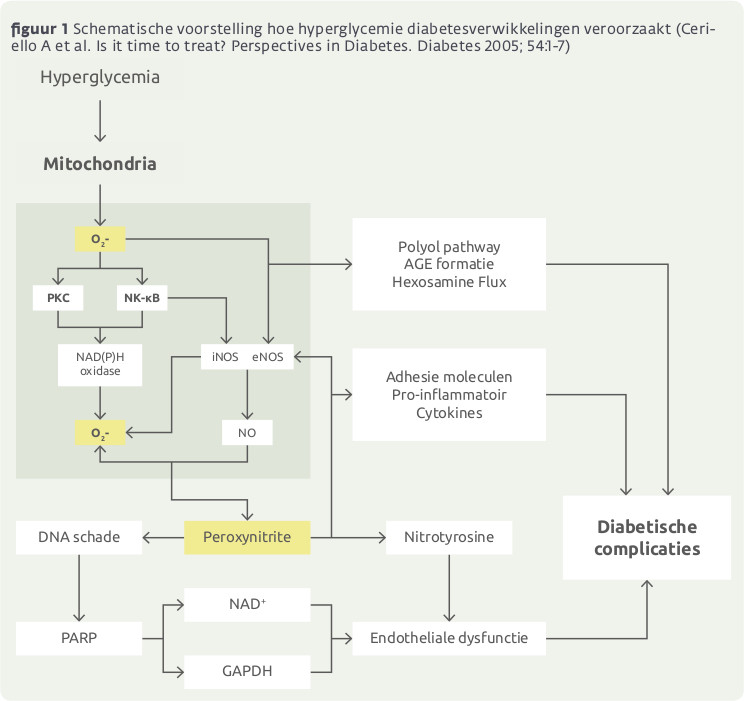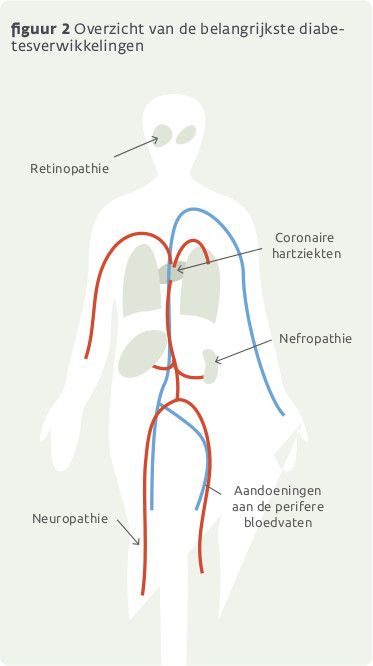
Diabetes is meer dan enkel maar verhoogde glucoseniveaus in het bloed. Het is evenmin een plots optredende ziekte, het is eerder de eindfase van een metabole ontsporing die al tientallen jaren aan de gang is. Het lichaam probeert zo lang mogelijk de verstoringen in de homeostase op te vangen door metabole aanpassingen, die echter wel hun prijs hebben op langere termijn. Het optreden van diabetes is het ogenblik waarop uiteindelijk de symptomen en gevolgen van deze ontsporing merkbaar worden.
Beste bezoeker, u heeft geen toegang.
Enkel (web)abonnees hebben toegang tot tijdschriftartikelen. Het webabonnement is nog in de maak.
U kunt zich wel alvast (gratis) registreren en tal van andere webartikelen raadplegen!
Trefwoorden:
Verschenen in
Referenties
(medalists)
http://www.joslin.org/diabetes-research/lessons-from-the-long-haul.html
Keenan HA et al. Clinical Factors Associated With Resistance to Microvascular Complications in Diabetic Patients of Extreme Disease Duration: The 50-year Medalist Study Diabetes Care 2007; 30(8):1995—1997
Sun JK, Keenan HA et al. Protection from retinopathy and other complications in patients with type 1 diabetes of extreme duration: the Joslin 50-year medalist study. Diabetes Care. 2011 Apr;34(4):968-74.
Keenan et al. Residual insulin production and pancreatic ß-Cell turnover after 50 years of diabetes: Joslin Medalist Study. Diabetes 2010;59:2846-2853.
Vinik A. The question is, my dear watson, why did the dog not bark?: the joslin 50-year medalist study.
Keenan et al. Clinical factors associated with resistance to microvascular complications in diabetic patients of extreme disease duration: the 50-year medalist study. Diabetes Care. 2007 Aug
(hoofdartikel)
Pruimboom L. Insulineresistentie ‘Een pandemisch probleem’. AT&A 2011; 2:30-35.
Meeusen J. Advanced glycation endproducts. Waarom suiker toxisch is. AT&A 2011; 2:38-43.
Ceriello A. Postprandial Hyperglycemia and Diabetes Complications.Is It Time to Treat? Diabetes J anuary 2005; 54:(1)1-7
de M Bandeira S et al. Oxidative stress as an underlying contributor in the development of chronic complications in diabetes mellitus. Int J Mol Sci. 2013 Feb 5;14(2):3265-84.
Bouhanick B, Barigou M, Kantambadouno JB, Chamontin B. Glycaemic control and complications of diabetes: What about? Presse Med. 2013 Mar 26. Epub ahead of print
Dandona P et al. Macronutrient intake induces oxidative and inflammatory stress: potential relevance to atherosclerosis and insulin resistance. EMM 2010; 42(4):245.
Folli F et al. The role of oxidative stress in the pathogenesis of type 2 diabetes mellitus micro- and macrovascular complications: avenues for a mechanistic-based therapeutic approach. Curr Diabetes Rev. 2011 Sep;7(5):313-24.
Goodpaster BH. Mitochondrial deficiency is associated with insulin resistance. Diabetes. 2013 Apr;62(4):1032-5.
Hernandez-Mijares A et al. Mitochondrial complex I impairment in leukocytes from type 2 diabetic patients. Free Radic Biol Med. 2011 May 15;50(10):1215-21.
Supale S, Li N, Brun T, Maechler P. Mitochondrial dysfunction in pancreatic β cells. Trends Endocrinol Metab. 2012 Sep;23(9):477-87.
Marchetti P et al. The beta-cell in human type 2 diabetes. Adv Exp Med Biol. 2010;654:501-14.
HbA1c targets in type 2 diabetes: guidelines and evidence. Drug Ther Bull. 2013 Apr 3. [Epub ahead of print]
Choi SH et al. Hemoglobin A1 as a Diagnostic T001 for Diabetes Screening and New-Onset Diabetes Prediction Diabetes Care April 2011 vol. 34 na. 4 944-949
Esposito K et al. Inflammatory Cytokine Concentrations Are Acutely Increased by Hyperglycemia in Humans. 2002 American Heart Association
Geraldes P, King GL. Activation of Protein Kinase C Isoforms and Its Impact on Diabetic Complications. Circulation Research. 2010; 106: 1 3 19
Ahmed N, Thornalley PJ. Advanced glycation endproducts: what is their relevance to diabetic complications? Diabetes Obes Metab. 2007 May;9(3):233-45.
Ansari NA, Rasheed Z. Non-enzymatic glycation of proteins: from diabetes to cancer. Biomed Khim. 2010 Mar—Apr;56(2):168-78.
Edeas M, Attaf D, Mailfert AS, Nasu M, Joubet R. Maillard reaction, mitochondria and oxidative stress: potential role of antioxidants. Pathol Biol (Paris). 2010 Jun;58(3):220-5.
Szabo C. Role of nitrosative stress in the pathogenesis of diabetic vascular dysfunction. Br J Pharmacol. 2009 Mar;156(5):713-27.
Hernandez-Mijares A et al. Human Leukocyte/Endothelial Cell Interactions and Mitochondrial Dysfunction in Type 2 Diabetic Patients and Their Association With Silent Myocardial Ischemia. Diabetes Care. 2013 Jan 8. [Epub ahead of print]
Nys M. Co-enzym Q10: diabetes, obesitas en andere pathologieën. AT&A 2011; 4:17-21.
Cheng X, Siow RC, Mann GE. Impaired redox signaling and antioxidant gene expression in endothelial cells in diabetes: a role for mitochondria and the nuclear factor-E2-related factor 2-Kelch-like ECH-associated protein 1 defense pathway. Antioxid Redox Signal. 2011 Feb 1;14(3):469-87.
Matheus AS et al. Impact of diabetes on cardiovascular disease: an update. Int J Hypertens. 2013:653789.
Klein BEK, Knudtson MD, Tsai MY, KleinR. The Relation of Markers of Inflammation and Endothelial Dysfunction to the Prevalence and Progression of Diabetic Retinopathy. Arch Oft V01. 127 N0. 9, September 2009
Nakagawa T, Long DA et al. Abnormal Angiogenesis in Diabetic Nephropathy. Diabetes 2009; 58(7):1471-1478.
Ceriello A. Hyperglycaemia and the vessel Wall: the pathophysiological aspects on the atherosclerotic burden in patients With diabetes. Eur J Cardiovasc PreV&Rehab 2010; 17(1): s15-s19
Nooyens ACJ ‚Baan CA, Spijkerman AMW, Verschuren WMM. Type 2 Diabetes and Cognitive Decline in Middle-Aged Men and Women: The Doetinchem Cohort Study. Diabetes Care September 2010 3321964-1969.
Allam AR et al. Alzheimer's disease and Type 2 diabetes mellitus: the cholinesterase connection? Lipids in Health and Disease 2006, 5:28
XU Q et al. Diabetes and Risk of Parkinson’s Disease. Diabetes Care 2011; 34(4): 910-915
Gresele P et al. Hyperglycemia-Induced Platelet Activation in Type 2 Diabetes Is Resistant to Aspirin but Not to a Nitric Oxide-Donating Agent. Diabetes Care J une 2010; 33(6): 1262-1268.
Zavrelova H, Dekker J M et al. Progression and Regression: Distinct Developmental Patterns of Diabetic Retinopathy in Patients With Type 2 Diabetes Treated in the Diabetes Care System West-Friesland, the Netherlands. Diabetes Care April 2011342867-872
Yu Y, Feng L, Shao Y, Tu P, Wu HP, Ding X, Xiao WH. Quality of life and emotional change for middle-aged and elderly patients with diabetic retinopathy. Int J Ophthalmol. 2013;6(1):71-4.
Sun YM, Su Y, Li J, Wang LF. Recent advances in understanding the biochemical and molecular mechanism of diabetic nephropathy. Biochem Biophys Res Commun. 2013 Mar 26. [Epub ahead of print]
Bentata Y, Haddiya I, Latrech H, Serraj K, Abouqal R. Progression of diabetic nephropathy, risk of end-stage renal disease and mortality in patients with type-1 diabetes. Saudi J Kidney Dis Transpl. 2013 Mar-Apr;24(2):392-402.
de Boer IH et al. Long-term renal outcomes of patients with type 1 diabetes mellitus and microalbuminuria: an analysis of the Diabetes Control and Complications Trial/Epidemiology of Diabetes Interventions and Complications cohort. Arch Intern Med. 2011 Mar 14;171(5):412-20.
Rovira-Llopis S et al. Is myeloperoxidase a key component in the ROS-induced vascular damage related to nephropathy in type 2 diabetes? Antioxid Redox Signal. 2013 Mar 25. [Epub ahead of print]
Ježek P, Dlasková A, Plecitá-Hlavatá L. Redox homeostasis in pancreatic β cells. Oxid Med Cell Longev. 2012;2012:932838.







